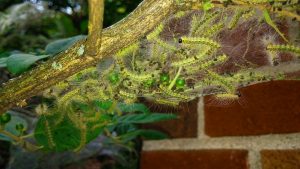You may have been seeing them – unsightly webs in trees, in parks or around your home. These particular webs are surprisingly not caused by spiders, but instead, caterpillars. The most likely culprits: the fall webworm and Eastern tent caterpillar. In this blog we are showcasing the fall webworm.
A bit of a description: Fall webworm caterpillars are highly variable in coloration, ranging from a pale yellow to dark grey, with long and short bristles all over their bodies. At their largest, the caterpillars may reach one inch or so in length. Their webs are seen generally in the late summer or early fall, on nearly 90 species of deciduous trees including birch, cherry, crabapple and hickory. The webs of the fall webworm are mainly concentrated on the tips of branches, in contrast to the Eastern tent caterpillars which make their webs in the cruxes of the trees. Inside the webs you can find caterpillars, dead and partially consumed or skeletonized leaves, and fecal droppings.
The caterpillars feed on the leaves of the trees they are infesting, eating inside of their web tents. As the caterpillars grow larger, they add more to their web, enclosing more foliage to feed on. In about 6 weeks, the larvae mature and move to the leaf litter beneath the tree to pupate into their adult moth stage.
Due to the fact that fall webworms eat leaves late in the season and only in particular spots on the trees, there is rarely any significant damage done to the trees they feed on. They can, however, occasionally kill trees if they are heavily infested over consecutive years, or if the trees are already distressed by other environmental conditions. This, along with the webs looking rather unattractive, are reasons why homeowners look to eradicate these common pests.
For removing these webs and the caterpillars, one of the easiest and most effective ways is to destroy the webs by hand, with a tool such as a long rake or pole (or a stick). A strong enough stream of water can also destroy the webs. Insecticides such as Malathion or pyrethrin in limited quantities could be saturated outside of the web or onto the caterpillars directly if possible. Do not attempt to set fire to the webs for removal!
Pruning may seem like an easy go-to option as well, but keep in mind that not just bugs can infest a tree. Pruning, especially in ornamental trees, can make trees more susceptible to the black knot fungus. If you ever choose to prune to remove the webs, be sure to sterilize the shears between cuts, and follow proper sterilization and disposal procedures.
You can also choose to let nature help eradicate these caterpillars, utilizing their natural predators such as wasps and birds. Some are able to pierce through the webs, but you can help them access the webworms by tearing a hole into their webs. Be careful when opening webs, though, as you could have caterpillars, leaves and droppings fall onto you! The caterpillars have minor defences against predators, such as thrashing collectively and irritants on their hairs, but are listed as non-venomous and therefore pose little threat to you unless you are allergic to their hairs.
Only use products labelled for use on caterpillars and be sure to wear proper safety equipment. Though treatment for the bugs is not always required, you can always give us a call at 1-888-768-5467 and we will be happy to help you out! Remember – there’s no foolin’ with Poulin!

